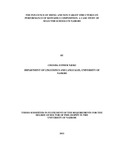| dc.description.abstract | This study focuses on the morphosyntactic errors in written Kiswahili that result from the
influence of Sheng and non-target structures. The study attempts a morphosyntactic analysis
of Sheng and non-target structure to determine their influence on Standard Kiswahili
proficiency of form three learners. The main objective of the study was to identify the Sheng
morphosyntactic structures, provide linguistic description and explore communication
strategies used by learners in their attempt to attain linguistic competence. A detailed
typology of these morphosyntactic deviations is given and their source and implications on
the national examination discussed.
The study was guided by Interlanguage theory as proposed by Selinker (1972). Sheng
morphosyntactic structures were analysed using the five successive steps of error analysis
theoretical model of identification, description, explanation, evaluation and recommendation.
The sample of the study consisted of 368 learners drawn from nine schools from the eight
divisions of Nairobi County namely; Central, Dagoretti, Embakasi, Kasarani, Kibera,
Makadara, Pumwani and Westlands
The sample population was obtained through purposeful and stratified sampling. The data
comprised of oral and written compositions by form three students from nine schools. The
scripts were marked and oral compositions transcribed. The errors obtained from the written
and oral compositions and the identified errors attributable to Sheng interlanguage were
analysed and categorized into five grammatical categories. Errors related to noun classes
were also analysed and the correct Kiswahili Standard form given. The frequency and
distribution of errors was determined subject to the five grammatical categories and in
conformity with the objectives of the study.
Statistical distribution of Sheng morphosyntactic structures obtained from the corpus
generated by the learners were presented. Manifestation of the psycholinguistic processes as
put forward by Selinker was assessed in terms of their distribution and frequency. A brief
comparative assessment of Sheng and pidgin was done to determine whether Sheng can be
classified in the same category with pidgin.
On the basis of the findings of this study, Sheng morphosyntactic structures were found to be
a prevalent feature in the written and oral compositions of form three learners. This is a major
hindrance to the attainment of curriculum goals. The findings from the analysis revealed that
the oral and written form three compositions have various Sheng-related morphosyntactic
errors that hinder the attainment of the objectives of the prescribed Kiswahili syllabus. In
light of these findings, several recommendations were made, among them formulating
school- based language policies that will encourage Standard Kiswahili proficiency. | en |

